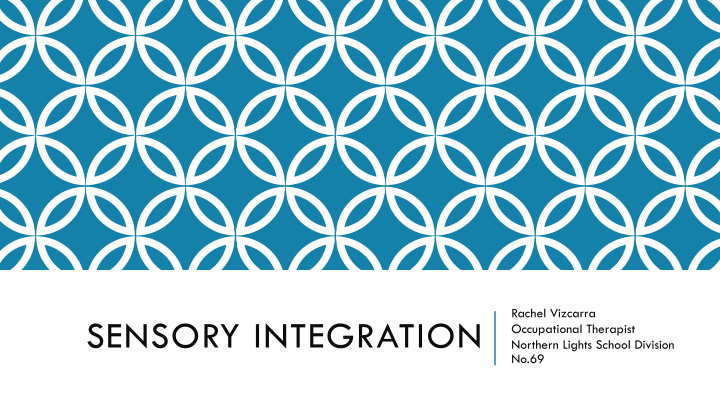



Rachel Vizcarra SENSORY INTEGRATION Occupational Therapist Northern Lights School Division No.69
WHAT IS SENSORY INTEGRATION? How our senses work together to give us information about our environment. Organize this information Receive information through our senses Use it to interact with the environment
OUR SENSES Internal Sense External Sense Receive information from external world Help us to develop our body awareness � Tactile (Touch) � Olfactory (Smell) & gustatory (Taste) � Vestibular sense � Visual (See) & auditory (Hear) � Proprioceptive sense Our body fine tunes these senses as we learn in a positive way through our environment
COMPONENTS SUPPORTING ACADEMIC LEARNING
HTTPS://WWW.YOUTUBE.COM/WATCH?V=1_IUJ8DR9OY
PRIMARY FOCUS IN SCHOOLS: SELF-REGULATION ▪ The ability to attain, maintain, and change level of alertness appropriately for a task or situation. ▪ Help students develop these skills by providing a structured environment and the tools to self-regulate
LEVEL OF ALERTNESS
SENSORY STRATEGIES (SENSORIMOTOR) TO SELF-REGULATE Self-regulate Touch Vision Listen Move Oral Input
DEVELOPMENT OF SELF- REGULATION 1 st order 2 nd order 3 rd order Self- self- self- regulation regulation regulation (Oetter et al., 1993)
DEVELOPMENT OF SELF- REGULATION - This level regulates: - Automatic functions of the body (i.e. 1 st order breathing, body temperature, sleep- wake cycles) Self- - Muscle tone - Monitoring for survival - Development begins at infancy regulation - Involves the autonomic nervous system, reticular system, and limbic system (Oetter et al., 1993)
DEVELOPMENT OF SELF- REGULATION - Infants begin to develop 2 nd order self- 2 nd order regulation strategies by using their 7 senses unconsciously Self- - As children develop, they unconsciously become more sophisticated in their ability to choose, use and refine sensorimotor regulation strategies for self-regulation (Oetter et al., 1993)
DEVELOPMENT OF SELF- REGULATION - 3 rd order self-regulation strategies require higher-level cognitive skills to: 3 rd order - Problem-solve - Self-Monitor Self- - Recognize need to change or maintain level of alertness - Working memory regulation - Organization (Oetter et al., 1993)
SENSORY STRATEGIES (SENSORIMOTOR) TO SELF-REGULATE Self-regulate Consciously choose strategies to alert or calm self (self- regulate) Touch Vision Listen Move Oral Input • Think about morning routine • Think about bed time routine
SENSORY STRATEGIES (SENSORIMOTOR) TO SELF-REGULATE Self-regulate Fidget Tools Touch Vision Listen Move Oral Input
HOW DO FIDGET TOOLS HELP? ▪ Provides the opportunity to stimulate vestibular sense (movement) ▪ Provides the opportunity to stimulate tactile sense (touch) ▪ Different textures can be alerting, calming or organizing Sensory input (i.e. through movement and touch) stimulates the nervous system to stay alert, which helps students to focus and pay attention in school.
Recommend
More recommend